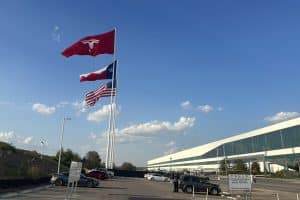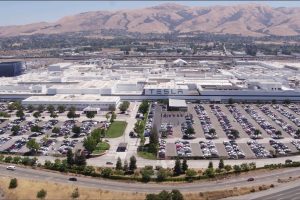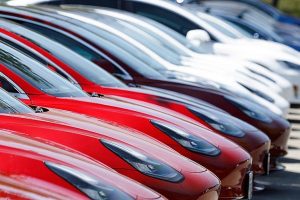The Biden administration wants to spend $7.5 billion to construct a more robust EV charging network for electric car drivers in the United States. The Tesla Supercharger system is by far the largest high speed charging network in America. With 1278 charging plazas and more than 13,000 chargers, it controls 58% of all the DC fast chargers in the country.
Not only that, the vast majority of those chargers are in working order most of the time. The process is seamless. Plug in, charge, and drive away. No apps or special membership cards needed. The cost of each charging session is displayed in real time right on the car’s touchscreen and billed directly to the customer’s My Tesla account. Simple, fast, reliable. What’s not to like?
Making Tesla Superchargers available to drivers of other electric cars would give a big boost to the Biden administration’s plans. According to Energy Wire, Tesla has made a proposal to the federal government that would make access to is Superchargers possible for all drivers. Under the plan, Tesla would get federal funding for each public charging stall it creates.
But there’s a catch, Energy Wire says. The company also wants federal money for chargers that are reserved exclusively for use by Tesla drivers. “They’re trying to have it both ways,” says John Gartner, a senior director at the Center for Sustainable Energy, a nonprofit advisory group.
Supercharger Vs. CHAdeMO Vs. CCS
There is a lot of history surrounding EV charging standards. Some say Elon Musk pioneered new technology. Others say he balked at creating a charging network that others could use, despite his public pronouncements that he never intended the Supercharger network to be a “walled garden.” For a while, the Japanese CHAdeMO standard gave the Tesla Supercharger standard a run for its money, but CHAdeMO faded as Tesla ramped up charging power to 150 kW, then 200 kW, and beyond. The Biden proposal includes no money for new CHAdeMO chargers.
The new kid on the block is CCS, which has become the de facto charging standard in Europe. Some say it is inferior to the Tesla standard, but bear in mind that Sony’s BetaMax was superior to VHS, yet VHS ultimately won the video cassette competition. There is every possibility that CCS may come to dominate in most parts of the world even if it is technically not quite up to snuff when compared to Tesla’s system. The jury is still out on that debate, but Tesla has begun welcoming other electric cars at its Supercharger locations in Europe. Convergence is happening, even if it is not yet complete.
The Tesla Supercharger Plan
“I think it has the potential to be a pretty big deal,” says Chris Harto, a policy analyst at Consumer Reports. “Under the radar, [Tesla’s] best competitive advantage is their network and exclusive access to their network.” He adds, “Large, serviceable, and in the right places, Tesla’s fueling stations are far more comprehensive than anyone has out there.” In addition, Tesla Supercharger plazas tend to be larger than those of its rivals. While a non-Tesla charging plaza often has two to six stalls, Tesla plazas on average have 10 or more. Some locations in busy areas have more then 40.
Sources tell Energy Wire that access to the Tesla Supercharger network could help lower a couple of barriers that face federal and state officials who want government money to serve as many cars as possible, as soon as possible. Building a fast charging plaza from scratch can cost millions of dollars and take 18 months or more to build. Planners must negotiate for a location, traverse a thicket of permits, and sometimes get new grid infrastructure installed to supply enough juice. “Tesla opening up their network to all other users would be a game-changer in terms of infrastructure availability for all EVs,” Chris Harto says,
Supercharger plazas, by virtue of their prime locations, are easy for drivers to spot. Knowing where charging stations are located goes a long way toward resolving the range anxiety drivers experience and helps them feel comfortable buying an electric car in the first place. “The fact that Tesla has the highest market share among [original equipment manufacturers] and that their charging network is among the most visible, that will do a lot to alleviate those concerns,” Gartner says.
For its first round of funding, the Biden administration wants to fill in the gaps along major traffic routes. Many of these “alternative fuel corridors,” as the government calls them, are already populated by Supercharger stations.
Tensions Between The Government & Tesla
The prospect of cooperation between Tesla and the Biden administration is complicated by their clashing agendas over union labor and a host of regulatory issues. Musk has railed against the president, going so far as to call him a “sock puppet” on Twitter, while Biden maintained a strict silence on the topic of America’s top EV maker until just a few weeks ago
There will be bumps in the road going forward, Energy Wire says. In its proposal, Tesla is asking for funding for each CCS charger it installs. But there’s more to it. The company says, “Tesla or CHAdeMO connectors should be eligible for rebates as long as there is a CCS connector at the location for every rebated Tesla or CHAdeMO connector,” the company says.
Tesla suggests that for every CCS connector it installs, it should also get a “rebate” for a Tesla-only connector it already has onsite. But Congress designated the money only for chargers that everyone can use and intended to promote new infrastructure, not pay for chargers that are already built. “I don’t think that’s going to fly,” says Harto. “I don’t think that’s a reasonable thing to ask for.”
Tesla also has to consider how its customers will feel about the new arrangement. If a Tesla driver pulls into a Supercharger plaza and finds all the chargers are being used by Ford, Rivian, Volkswagen, Hyundai, and Kia drivers, the implied promise Tesla made to its customers that they would have exclusive access to a dedicated fast charging network will be severely tested.
“Right now they’re trying to balance what the value is of keeping our network closed, because that gives us an advantage in selling vehicles,” Harto said, “as opposed to opening up to other drivers, which would increase the utility of those resources they’ve already invested in. I think they’re kind of weighing those two benefits.”
We would be interested in hearing from our readers who are Tesla owners, as well as those who drive electric cars from other manufacturers, about how they feel about the Tesla proposal to open the US Supercharger network to all drivers.





